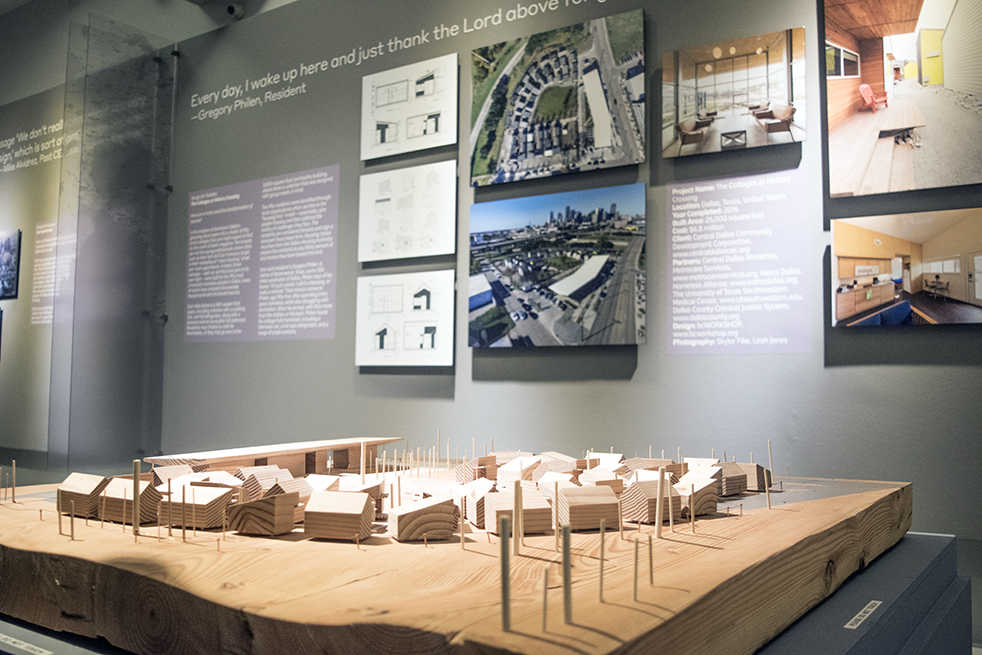Nestled across from the famous High Museum of Art is the smaller yet no less impressive Museum of Design Atlanta (MODA). After walking into the glassy and colorful building, museum-goers are led down a hallway stamped with stark text and enlarged black-and-white photos. The hallway is segmented by large panels, and after visitors tilt their heads to get a better glimpse, they are confronted with striking questions — “Where do you learn?” “Where do you sleep?” “Where do you live?”
These are the questions that shape “Design for Good: Architecture for Everyone,” MODA’s current exhibit curated by architect, speaker and writer John Cary. Often, social-justice outreach and health initiatives are focused on the “How?” but rarely do they focus on the “Where?” But slowly, people are beginning to understand that where outreach occurs is heavily linked to how impactful it is. The first hallway cleverly introduces the core idea of the exhibit — “everyone deserves good design.”
After emerging from the hallway, visitors arrive in an open space with sections allotted to case studies of architecture projects, all significant examples of the impact that good design can have. Each case study includes important profiling information, including the location, cost and source of funding for the project. These profiles are accompanied by vibrant images and quotes from clients that weave together to tell a story of what beautiful architecture made with the aim of maximization can do for community.
The case studies are brought to life by architectural models, the most engaging part of the curation. These to-scale models provide an aerial view of the individual projects, allowing the visitor to view them from different angles and truly appreciate the work in a way that photographs do not allow.
One prominent case study is the “Maternity Waiting Village” in rural Malawi, a shelter which gives local pregnant women a place to stay so they can have immediate access to health care. This village was created with the intent to improve on previous shelters, which were essentially “brick blocks” built like a “stable.” With this example, Cary makes it clear that “design for good” means using design to dignify the lives of those who have not been allowed that decency.
Another case study discussed is the “Women’s Opportunity Center” in Rwanda, a cluster of mud-brick pavilions in which Rwandan women and children can gather and learn. Each pavilion is an intricate spiral with recessed seating, a modern design that highly contrasts its surroundings, and at night time, the lit shelters look like lanterns or beacons of hope. The Women’s Center has given Rwandan women not only a place to call their own, but a place they are proud of. Cary uses this study to highlight that when respect is given to people, they are then in turn able to respect themselves and the world around them.
Cary’s most unique look at the impact of architecture is an project a little closer to home, The National Memorial for Peace and Justice in Montgomery, Alabama. Cary’s curation, which remembers the thousands of victims of lynching, highlights the intention behind the construction of the memorial. The exhibit communicates how the memorial manages to physicalize the weight of lynching tragedies rather than intellectualizing or even just dismissing them as numbers. At this point in the tour, visitors understand that good design can show that even those who are gone are deserving of dignity. Cary even covers a design project close to Tech students’ hearts — and Tech’s campus — by including a brief overview of the impact of the Atlanta BeltLine.
MODA defines “design” as the intersection of creativity and functionality, and the “Design for Good” exhibit exemplifies this juncture. Design is everywhere, and Cary puts it perfectly — “It’s about the lives all of us lead, inextricablty shaped by the spaces we inhabit.” “Design for Good: Architecture for Everyone” is a must for anyone who wishes to broaden their understanding of design and understand the functional implications that creative design has on everyday life. While not as visually stimulating as other exhibits, the weight of Jon Cary’s message and the stories of those impacted by good design make MODA’s current exhibit a worthwhile and enriching visit.
